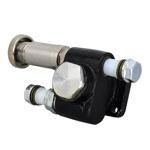Information injection-pump assembly
BOSCH
9 400 613 181
9400613181
ZEXEL
101405-9232
1014059232
YANMAR
12991651001
12991651001
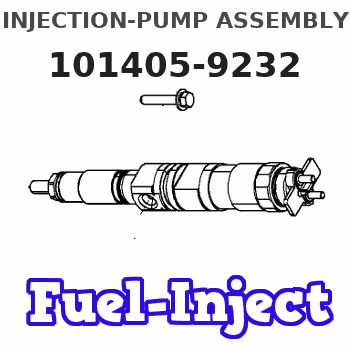
Rating:
Service parts 101405-9232 INJECTION-PUMP ASSEMBLY:
1.
_
5.
AUTOM. ADVANCE MECHANIS
6.
COUPLING PLATE
7.
COUPLING PLATE
8.
_
9.
_
10.
NOZZLE AND HOLDER ASSY
11.
Nozzle and Holder
12.
Open Pre:MPa(Kqf/cm2)
13.
NOZZLE-HOLDER
14.
NOZZLE
15.
NOZZLE SET
Cross reference number
BOSCH
9 400 613 181
9400613181
ZEXEL
101405-9232
1014059232
YANMAR
12991651001
12991651001
Zexel num
Bosch num
Firm num
Name
101405-9232
9 400 613 181
12991651001 YANMAR
INJECTION-PUMP ASSEMBLY
4TNE94 K 14BC INJECTION PUMP ASSY PE4A,5A, PE
4TNE94 K 14BC INJECTION PUMP ASSY PE4A,5A, PE
Calibration Data:
Adjustment conditions
Test oil
1404 Test oil ISO4113 or {SAEJ967d}
1404 Test oil ISO4113 or {SAEJ967d}
Test oil temperature
degC
40
40
45
Nozzle and nozzle holder
105780-8140
Bosch type code
EF8511/9A
Nozzle
105780-0000
Bosch type code
DN12SD12T
Nozzle holder
105780-2080
Bosch type code
EF8511/9
Opening pressure
MPa
17.2
Opening pressure
kgf/cm2
175
Injection pipe
Outer diameter - inner diameter - length (mm) mm 6-2-600
Outer diameter - inner diameter - length (mm) mm 6-2-600
Overflow valve
131424-1520
Overflow valve opening pressure
kPa
157
123
191
Overflow valve opening pressure
kgf/cm2
1.6
1.25
1.95
Tester oil delivery pressure
kPa
157
157
157
Tester oil delivery pressure
kgf/cm2
1.6
1.6
1.6
Direction of rotation (viewed from drive side)
Right R
Right R
Injection timing adjustment
Direction of rotation (viewed from drive side)
Right R
Right R
Injection order
1-3-4-2
Pre-stroke
mm
3.6
3.55
3.65
Beginning of injection position
Drive side NO.1
Drive side NO.1
Difference between angles 1
Cal 1-3 deg. 90 89.5 90.5
Cal 1-3 deg. 90 89.5 90.5
Difference between angles 2
Cal 1-4 deg. 180 179.5 180.5
Cal 1-4 deg. 180 179.5 180.5
Difference between angles 3
Cyl.1-2 deg. 270 269.5 270.5
Cyl.1-2 deg. 270 269.5 270.5
Injection quantity adjustment
Adjusting point
A
Rack position
9
Pump speed
r/min
800
800
800
Average injection quantity
mm3/st.
44.7
43.7
45.7
Max. variation between cylinders
%
0
-2.5
2.5
Basic
*
Fixing the lever
*
Injection quantity adjustment_02
Adjusting point
C
Rack position
6.8+-0.5
Pump speed
r/min
450
450
450
Average injection quantity
mm3/st.
13
12
14
Max. variation between cylinders
%
0
-15
15
Fixing the rack
*
Injection quantity adjustment_03
Adjusting point
D
Rack position
9.5++
Pump speed
r/min
100
100
100
Average injection quantity
mm3/st.
65
60
70
Fixing the lever
*
Rack limit
*
Test data Ex:
Governor adjustment
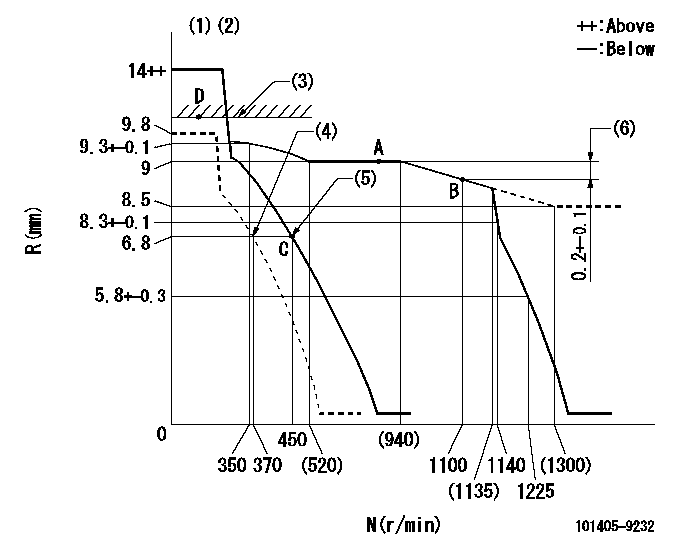
N:Pump speed
R:Rack position (mm)
(1)Target notch: K
(2)Tolerance for racks not indicated: +-0.05mm.
(3)RACK LIMIT
(4)Set idle sub-spring
(5)Main spring setting
(6)Rack difference between N = N1 and N = N2
----------
K=10 N1=1100r/min N2=800r/min
----------
----------
K=10 N1=1100r/min N2=800r/min
----------
Speed control lever angle

F:Full speed
I:Idle
(1)Stopper bolt setting
----------
----------
a=5deg+-5deg b=22deg+-5deg
----------
----------
a=5deg+-5deg b=22deg+-5deg
Stop lever angle
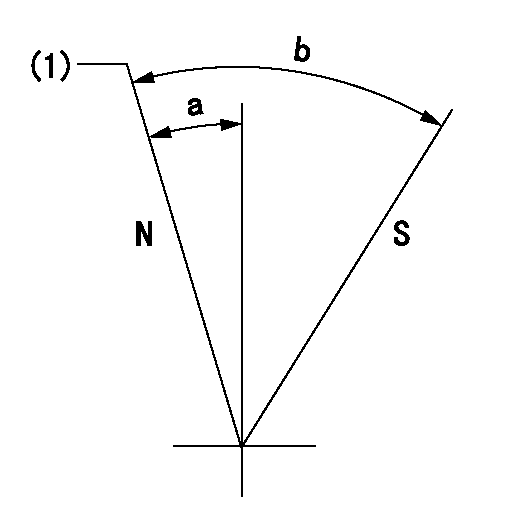
N:Pump normal
S:Stop the pump.
(1)Normal
----------
----------
a=10deg+-5deg b=53deg+-5deg
----------
----------
a=10deg+-5deg b=53deg+-5deg
Timing setting
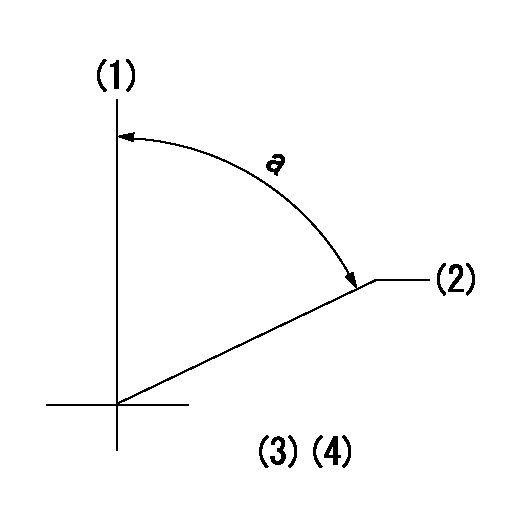
(1)Pump vertical direction
(2)Position of camshaft's key groove at No 1 cylinder's beginning of injection
(3)-
(4)-
----------
----------
a=(60deg)
----------
----------
a=(60deg)
Information:
Downhill
When cresting a hill, the decision of whether to use power or not on the downside of the hill must be made. Best fuel economy results from using minimum power to get back to speed after climbing a grade. However, care must be taken not to allow the engine to overspeed. This engine should not exceed 2300 rpm. The PEEC cruise control may use full engine power to return the truck to the cruise set speed if the engine was unable to maintain the set speed while climbing a hill. The cruise control should be turned off before cresting the top of a hill and light throttle used to regain vehicle speed on a downhill to minimize fuel consumption.If equipped with an exhaust brake, the engine should not exceed maximum braking rpm. Refer to "Auxiliary Exhaust Brakes" section of this manual.Saving Fuel On Hills
Rolling hills provide a great opportunity to reduce fuel. Avoid downshifting on small hills. If a hill can be topped without downshifting, even if the engine lugs to the peak torque rpm (1100 - 1200), the truck should not be downshifted.On long grades that require one or more downshifts, let the PEEC engine lug back to the peak torque rpm. If road speed stabilizes with the engine running at or above peak torque rpm, remain in that gear. When going down hill, use gravity instead of engine power to regain vehicle speed.Long steep down grades should be anticipated. Vehicle speed should be reduced before cresting the top of a hill and proceeding down a long steep grade. The way to achieve maximum fuel efficiency, is to minimize the amount of braking that is used to maintain a safe vehicle speed.The engine's ability to hold the truck back increases with engine speed. A gear should be selected that runs the engine near the high engine rpm limit for long steep hills when braking is required.Speed reductions and future stops should be anticipated ahead of time to save fuel. Downshifts should be avoided and the amount of braking minimized to improve fuel consumption.Cruising Speed
It's a simple fact that the faster a vehicle is driven the more fuel it will consume. A few miles per hour (km/h) can make a significant difference in fuel economy.Increasing cruising speed from 55 to 65 mph (88 to 104 km/h) will increase fuel consumption of a typical class 8 truck approximately 1.0 mpg (0.4 km/L). A practice of driving faster to increase stop time makes those stops very expensive.Cruising is the most common operating condition for most trucks and therefore, provides the greatest opportunity to benefit from operation in the most fuel efficient rpm range of the engine. A significant improvement in fuel economy can be realized by operating the truck in a gear that will keep the engine between 1400 and 1600 rpm.The PEEC can be programmed to limit vehicle speed and encourage operation in the highest gear during a cruising condition for optimum fuel economy.Cruise Control (CC)
The PEEC engine can
When cresting a hill, the decision of whether to use power or not on the downside of the hill must be made. Best fuel economy results from using minimum power to get back to speed after climbing a grade. However, care must be taken not to allow the engine to overspeed. This engine should not exceed 2300 rpm. The PEEC cruise control may use full engine power to return the truck to the cruise set speed if the engine was unable to maintain the set speed while climbing a hill. The cruise control should be turned off before cresting the top of a hill and light throttle used to regain vehicle speed on a downhill to minimize fuel consumption.If equipped with an exhaust brake, the engine should not exceed maximum braking rpm. Refer to "Auxiliary Exhaust Brakes" section of this manual.Saving Fuel On Hills
Rolling hills provide a great opportunity to reduce fuel. Avoid downshifting on small hills. If a hill can be topped without downshifting, even if the engine lugs to the peak torque rpm (1100 - 1200), the truck should not be downshifted.On long grades that require one or more downshifts, let the PEEC engine lug back to the peak torque rpm. If road speed stabilizes with the engine running at or above peak torque rpm, remain in that gear. When going down hill, use gravity instead of engine power to regain vehicle speed.Long steep down grades should be anticipated. Vehicle speed should be reduced before cresting the top of a hill and proceeding down a long steep grade. The way to achieve maximum fuel efficiency, is to minimize the amount of braking that is used to maintain a safe vehicle speed.The engine's ability to hold the truck back increases with engine speed. A gear should be selected that runs the engine near the high engine rpm limit for long steep hills when braking is required.Speed reductions and future stops should be anticipated ahead of time to save fuel. Downshifts should be avoided and the amount of braking minimized to improve fuel consumption.Cruising Speed
It's a simple fact that the faster a vehicle is driven the more fuel it will consume. A few miles per hour (km/h) can make a significant difference in fuel economy.Increasing cruising speed from 55 to 65 mph (88 to 104 km/h) will increase fuel consumption of a typical class 8 truck approximately 1.0 mpg (0.4 km/L). A practice of driving faster to increase stop time makes those stops very expensive.Cruising is the most common operating condition for most trucks and therefore, provides the greatest opportunity to benefit from operation in the most fuel efficient rpm range of the engine. A significant improvement in fuel economy can be realized by operating the truck in a gear that will keep the engine between 1400 and 1600 rpm.The PEEC can be programmed to limit vehicle speed and encourage operation in the highest gear during a cruising condition for optimum fuel economy.Cruise Control (CC)
The PEEC engine can
Have questions with 101405-9232?
Group cross 101405-9232 ZEXEL
Yanmar
101405-9232
9 400 613 181
12991651001
INJECTION-PUMP ASSEMBLY
4TNE94
4TNE94
